Welcome to the world of interior design, where every detail counts. Have you ever wondered how to create a harmonious living space that promotes your well-being? If yes, you’re in the right place! In this article, we will explore two of the most popular design philosophies: feng shui and hygge.
While both feng shui and hygge share the goal of creating an inviting and comfortable environment, they approach it from different perspectives. Feng shui is an ancient Chinese practice that focuses on harmonizing the energy flow within a space, while hygge is a Danish concept that embraces coziness and comfort.
By understanding the principles of feng shui and hygge, you can choose which approach best suits your personality and preferences and create a space that reflects your unique style. Join us on this journey to discover the differences and similarities between feng shui and hygge, and how to incorporate them in your living space to create your perfect sanctuary.
Key Takeaways:
- Feng shui and hygge are two popular design philosophies that focus on creating a harmonious living space.
- Feng shui aims to balance the energy flow within a space, while hygge embraces coziness and comfort.
- Understanding the principles of feng shui and hygge can help you create a living space that reflects your unique style.
An Introduction to Feng Shui
Welcome to the world of feng shui! This ancient Chinese practice has been used for thousands of years to create harmonious and balanced environments that promote well-being and prosperity. Understanding feng shui can help you optimize the energy flow within your living space and achieve a more fulfilling lifestyle.
Feng shui is based on the concept of qi, the life force energy that flows through all things. By arranging your home in specific ways, you can influence the flow of qi and create a space that supports your goals and desires.
There are many benefits to incorporating feng shui in your home. Not only can it help you feel more relaxed and at peace, but it can also enhance productivity, creativity, and abundance. Additionally, feng shui can improve your relationships, health, and overall happiness.
The Five Elements of Feng Shui
One of the key principles of feng shui is the use of the five elements: wood, fire, earth, metal, and water. Each element is associated with specific qualities and can be used to create a balanced and harmonious environment.
| Element | Colors | Shapes | Materials | Qualities |
|---|---|---|---|---|
| Wood | Green, Brown | Rectangle, Column | Wood, Bamboo | Growth, Vitality |
| Fire | Red, Orange, Purple, Pink | Triangle, Pyramid, Cone | Candles, Lights | Passion, Energy |
| Earth | Yellow, Brown | Square, Flat, Horizontal | Clay, Ceramic | Stability, Nourishment |
| Metal | White, Gray, Silver, Gold | Round, Hemisphere, Dome | Metal, Stone | Precision, Clarity |
| Water | Blue, Black | Curvy, Wavy, Irregular | Water Features, Mirrors | Flow, Abundance |
By incorporating these elements into your decor, you can create a more balanced and harmonious environment that supports your goals and desires.
Stay tuned for the next section, where we will cover the basics of feng shui and provide you with practical tips for incorporating this ancient practice in your home.
The Basics of Feng Shui
Understanding the basic principles of feng shui is key to incorporating it in your home. It involves arranging furniture, colors, and decor in a specific way to ensure the energy flow, known as qi, is balanced and positive. Here are some essential concepts to keep in mind:
The Bagua Map
The bagua map is an ancient tool used in feng shui to evaluate energy patterns in a space. It’s an octagonal grid that maps out different areas of your home, each corresponding to a different aspect of your life, such as wealth, health, and relationships. By placing the bagua map over your floor plan, you can identify areas that require attention and activate the corresponding energy.

The Five Elements
The five elements – wood, fire, earth, metal, and water – are crucial to understanding feng shui. Each element represents a different aspect of nature and has specific colors, shapes, and materials associated with it. By incorporating these elements in your decor, you can create a harmonious balance and tap into the energy that they represent.
Yin and Yang
Yin and yang are opposing energies that, when in balance, create harmony and well-being. Yin is associated with feminine, passive energy, while yang represents masculine, active energy. Feng shui seeks to create a balance of yin and yang in a space, which can be achieved through the arrangement of furniture and decor.
By incorporating these basic concepts into your home, you can create a space that promotes positive energy and a sense of well-being. In the next section, we will delve into practical decorating tips based on feng shui principles to help optimize the energy flow in your home and enhance your overall well-being.
Feng Shui Decorating Tips
Applying feng shui principles to your home can help you find balance and harmony. Here are some feng shui decorating tips to help you create a cozy and harmonious environment:
- Declutter: Clutter is one of the biggest obstacles to good feng shui. Keep your space clean and tidy by regularly decluttering your belongings and keeping surfaces clear.
- Choose calming colors: Colors have a big impact on the energy flow in your space. Choose calming colors, such as blues and greens, to create a sense of tranquility and relaxation.
- Add natural elements: Incorporate natural elements, such as plants or a water feature, to bring the outdoors inside and create a sense of balance.
- Position furniture thoughtfully: Position your furniture in a way that encourages conversation and promotes relaxation. Avoid placing furniture in a way that blocks the flow of energy in your space.
- Invite in natural light: Natural light is essential for good feng shui. Allow as much natural light into your space as possible, and add lamps or other light sources as needed to create a warm and inviting atmosphere.
Feng Shui vs Hygge
While feng shui focuses on balance and energy flow, hygge is all about creating a cozy and comfortable environment. Combining the two can result in a space that is both harmonious and inviting. Try incorporating plush blankets and soft pillows into your feng shui design to create a cozy nook that promotes relaxation and contentment.

“A balanced and harmonious environment can help you feel more productive and at peace with your surroundings.”
By finding harmony in your space, you can create a welcoming and serene environment that promotes well-being and happiness. Whether you’re applying feng shui principles, infusing your space with hygge elements, or combining the two, creating a cozy and harmonious environment can help you feel more productive and at peace with your surroundings.
An Introduction to Hygge
If you’re looking to create a cozy and comfortable atmosphere in your home, then hygge may be the design philosophy for you. Originating in Denmark, hygge (pronounced “hoo-gah”) embraces warmth, simplicity, and the enjoyment of life’s little pleasures. The focus is on creating a relaxing and contented environment that promotes well-being and happiness.
While feng shui and hygge share some similarities in terms of promoting well-being, they have distinct differences in their approach. While feng shui focuses on harmonizing the energy flow within a space, hygge is all about creating a sense of comfort and coziness. Both can be applied to your home to improve your overall well-being and create a harmonious living space.
The Essence of Hygge
Hygge is all about creating a warm and inviting atmosphere where you can unwind and relax. The focus is on creating a cozy environment with soft lighting, natural materials, and simple decor. It’s about surrounding yourself with things that bring you joy and comfort, such as fluffy blankets, scented candles, and warm drinks.
Hygge is also about enjoying the simple things in life, like spending time with loved ones, indulging in delicious food, and getting lost in a good book. It’s about finding pleasure in the moment and taking the time to slow down and appreciate the little things.
Hygge Decorating Tips
Creating a hygge environment in your home can be as simple as adding a few cozy touches. Here are some hygge-inspired decorating tips to get you started:
| Decorating Element | Description |
|---|---|
| Soft Lighting | Avoid harsh overhead lighting and opt for lamps, string lights, and candles instead to create a warm and inviting atmosphere. |
| Natural Materials | Incorporate natural materials, such as wood, wool, and linen, to create a cozy and tactile environment. |
| Cozy Textures | Add plush blankets, cushions, and rugs to create a comfortable and inviting space. |
| Simple Decor | Avoid clutter and opt for simple decor, such as plants and artwork, to create a calming and peaceful environment. |
| Ambient Sounds | Play soothing music or nature sounds to create a relaxing and calming atmosphere. |
By incorporating these simple elements, you can create a space that exudes warmth and comfort, promoting relaxation and contentment.
Whether you’re drawn to the energy flow of feng shui or the cozy atmosphere of hygge, understanding these design philosophies can help you create a space that promotes well-being and balance. By incorporating elements from both approaches, you can achieve a harmonious and inviting environment that reflects your unique personality and enhances your overall well-being.

The Essence of Hygge
At its core, hygge is about creating a warm, cozy, and inviting atmosphere that promotes relaxation and comfort. This Danish concept embraces the idea of nourishing your soul, finding joy in the simple things, and creating a space where you can fully unwind.
Soft lighting is a key element of hygge, with candles and string lights adding a warm and soothing ambiance to your space. Natural materials, such as wool, fur, and wood, create a tactile, inviting environment that is both grounding and comforting.
Hygge also emphasizes the importance of connecting with loved ones and creating a sense of community. Gathering around a table with good food, good wine, and good company is a cornerstone of the hygge lifestyle.
Ultimately, hygge is about finding balance and harmony in your life. Creating a cozy and inviting space that reflects your values, personality, and unique sense of style can help you achieve a more balanced and fulfilling lifestyle.
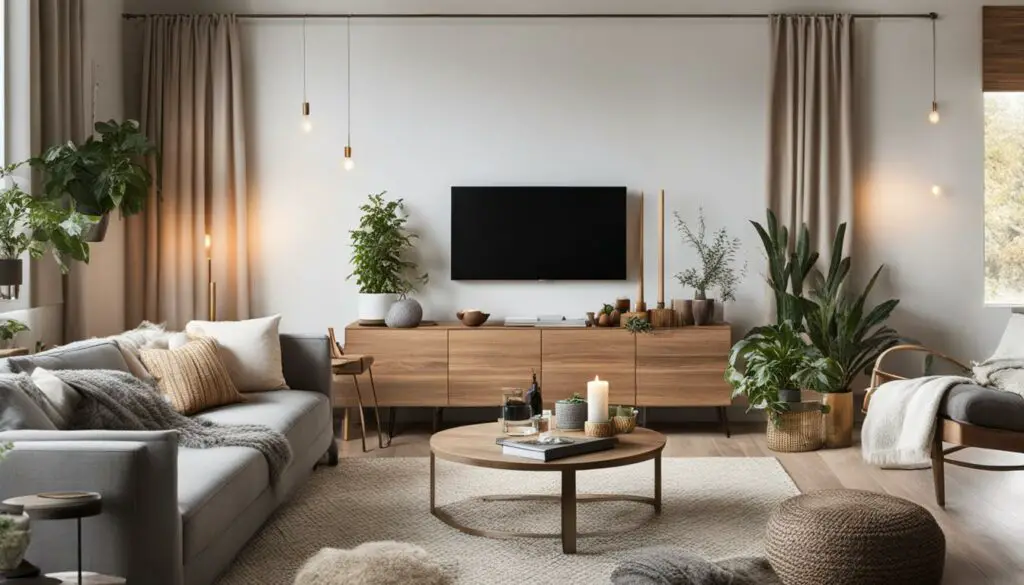
Hygge Decorating Tips
Incorporating hygge into your home is all about finding harmony and creating a cozy, harmonious environment that promotes relaxation and contentment. Here are some practical decorating tips to help you infuse hygge into your space:
- Soft Lighting: Add soft, warm lighting to your space with candles, fairy lights, or lamps. This will create a relaxing ambiance and add a touch of hygge to your home.
- Natural Materials: Embrace natural materials like wood, wool, and cotton. These textures will add warmth and comfort to your space, creating a cozy and inviting atmosphere.
- Texture: Incorporate texture into your decor with blankets, pillows, or a cozy rug. This will help create a sense of depth and comfort in your space.
- Creating a Cozy Nook: Create a spot in your home that is dedicated to relaxation. This could be a window seat, a reading nook, or a cozy chair. Add blankets, pillows, and your favorite book to create the perfect hygge retreat.
By incorporating these simple decorating tips, you can create a space that feels welcoming and comfortable, and that promotes relaxation and contentment.
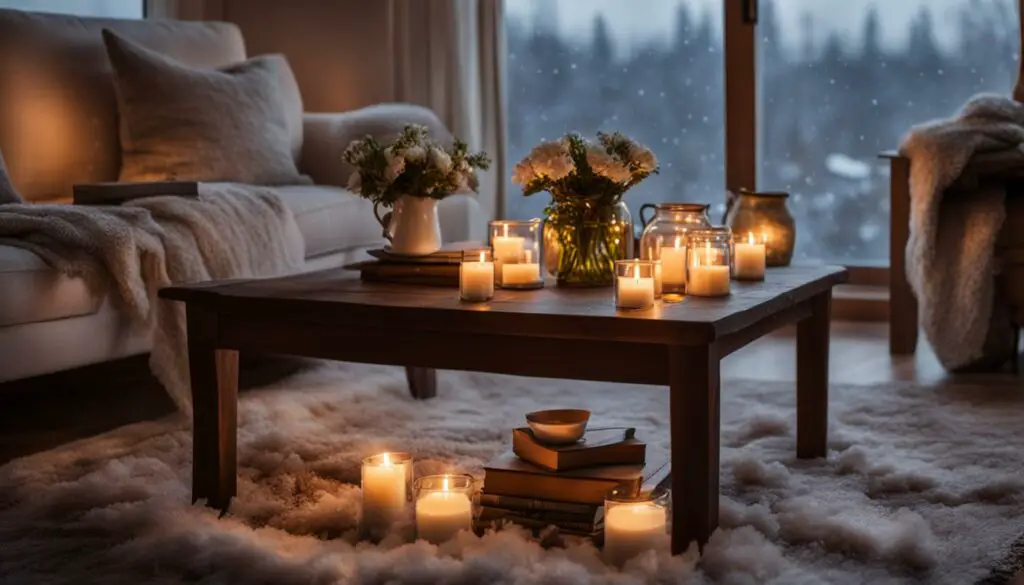
Finding Harmony: Feng Shui and Hygge Combined
Now that you have learned about the principles of feng shui and hygge, you may be wondering which one to choose for your home. The good news is that you don’t have to choose between the two. Feng shui and hygge can work together to create a harmonious and cozy environment that promotes your well-being.
The key to combining feng shui and hygge is finding a balance between the two. Feng shui emphasizes the flow of energy, while hygge focuses on creating a warm and comfortable atmosphere. By incorporating both principles, you can create a space that is both energizing and relaxing.
One way to combine the two is by using feng shui principles to arrange your furniture and decor, while incorporating hygge elements such as soft lighting, comfortable blankets, and natural materials like wood and wool. This will create a space that is well-balanced and inviting.
Another way to combine feng shui and hygge is by using color. Feng shui assigns specific colors to different areas of your home to promote balance and harmony, while hygge embraces warm and neutral tones like beige, brown, and gray. By using both color systems, you can create a cozy and harmonious environment that also promotes energy flow.
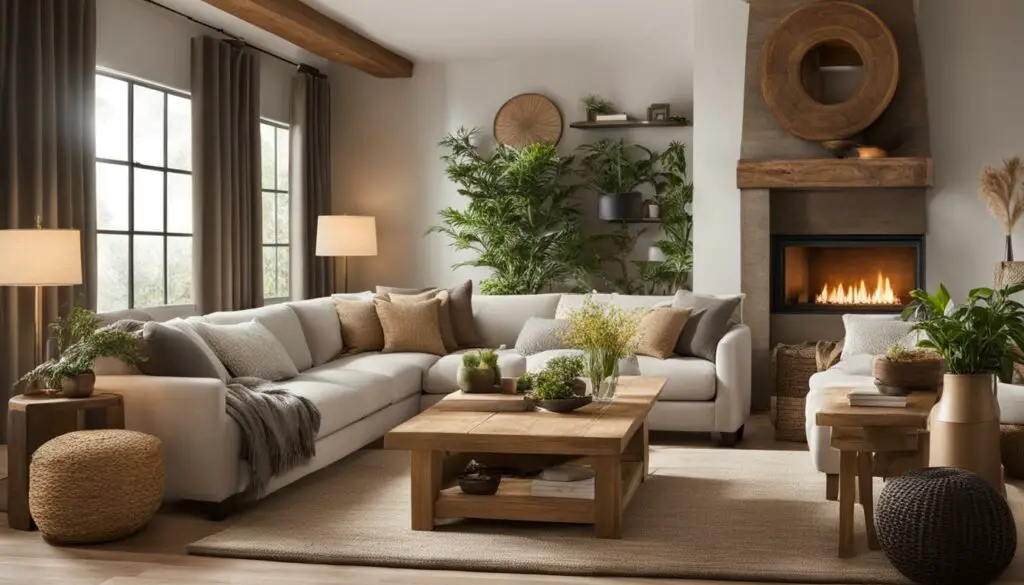
Creating a space that blends feng shui and hygge requires some experimentation and creativity. Don’t be afraid to try new things and see what works best for you. Remember, the goal is to create a space that reflects your unique personality and promotes your well-being.
Feng Shui and Hygge Combined: A Practical Example
Let’s say you want to create a cozy reading nook in your living room. To incorporate feng shui, you would want to choose a location that is in the “knowledge and self-cultivation” section of the bagua map. This area is associated with personal growth and learning, making it an ideal spot for a reading nook.
Next, you could arrange a comfortable chair and a small table with a lamp in this area, using feng shui principles to optimize the energy flow. Then, you could add hygge elements like a warm blanket, soft pillows, and a natural-wood bookshelf to create a cozy and inviting atmosphere.
By combining feng shui and hygge in this way, you have created a space that is not only conducive to reading and learning but also promotes relaxation and comfort.
Feng Shui and Hygge for Different Spaces
Whether you’re looking to create a serene retreat in your bedroom or a cozy gathering place in your living room, feng shui and hygge can be incorporated into every space in your home.
Feng Shui in the Bedroom
The bedroom is a vital space for rest and relaxation, and feng shui principles can help create a peaceful and soothing environment. Placing the bed in the command position, where you can see the door without being directly in line with it, is one of the most important feng shui principles for the bedroom. Choosing soft colors, adding comfortable bedding and pillows, and incorporating elements of the earth and water, such as plants and calming artwork, can also enhance the energy flow in your bedroom.
Hygge in the Living Room
The living room is often the heart of the home, and a place where you spend time with loved ones. The hygge approach to decorating this space involves a focus on comfort and warmth. Soft lighting, plush blankets and pillows, and natural materials such as wood and wool can all contribute to a cozy and inviting atmosphere. Adding personal touches such as family photos or sentimental objects can create a sense of intimacy and connection.
Feng Shui in the Home Office
With more people working from home, the home office has become an essential space for productivity and focus. Incorporating feng shui principles can help create a space that supports success and creativity. Bringing in natural light and adding plants can enhance the energy flow in the space. Placing the desk in the command position and keeping the area clutter-free can also increase productivity and focus.
Hygge in the Kitchen
The kitchen is a space where nourishment and connection come together. Embracing hygge in the kitchen can involve creating a warm and welcoming atmosphere with soft lighting, natural materials, and comfortable seating. Adding personal touches such as artwork or family photos, and incorporating natural elements such as fresh flowers or herbs can enhance the cozy and inviting ambiance of the space.
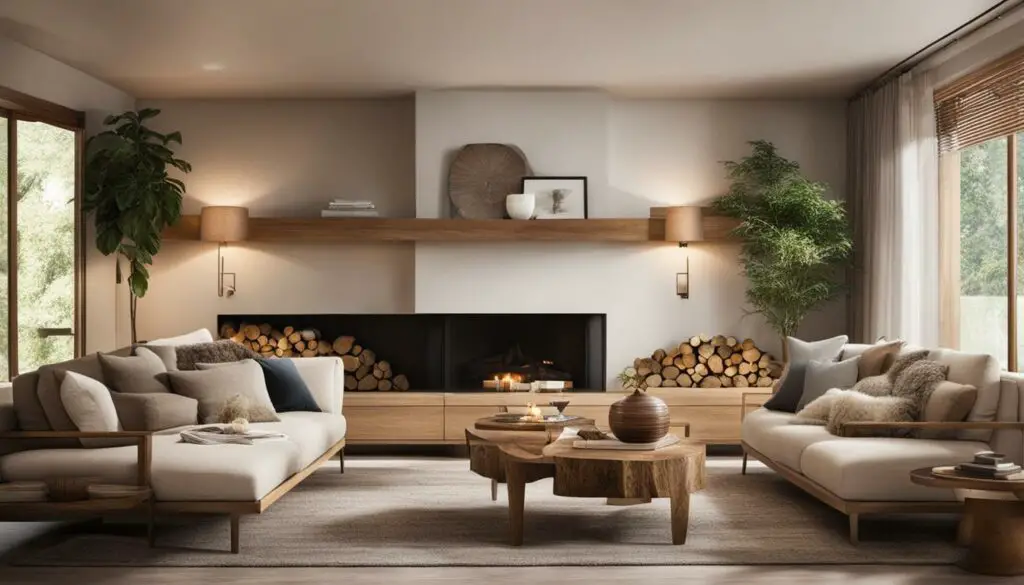
By incorporating feng shui and hygge principles in different spaces in your home, you can create a harmonious and inviting environment that supports your overall well-being. Whether you prefer the energy optimization of feng shui or the cozy warmth of hygge, finding ways to infuse these principles in every space can help you cultivate a balanced and fulfilling home.
Benefits of Feng Shui and Hygge
Embracing the principles of feng shui and hygge can bring numerous benefits to your life and home. By creating a cozy and harmonious environment, you can feel more relaxed, content, and at peace. Let’s explore some of the potential benefits of these two design philosophies:
- Improved well-being: Feng shui aims to balance the energy flow within a space, which can have a positive effect on your physical and mental health. Hygge’s emphasis on comfort and coziness can also promote relaxation and reduce stress.
- Better sleep: Feng shui’s focus on calm and balance can help create a more conducive sleeping environment. Integrating hygge elements like soft lighting and comfortable bedding can also help promote restful sleep.
- Enhanced productivity: Feng shui can optimize your workspace to promote concentration and creativity, while hygge’s cozy atmosphere can help you feel more relaxed and focused.
- Happiness: Both feng shui and hygge aim to create a positive and nurturing environment that promotes well-being and contentment.
By incorporating feng shui and hygge elements in your home, you can create a space that supports a more balanced and fulfilling lifestyle. From improved sleep and relaxation to enhanced productivity and happiness, the benefits of these design philosophies are numerous.

Feng Shui and Hygge for a Balanced Lifestyle
Embracing the principles of feng shui and hygge can extend far beyond interior design. By incorporating these philosophies into your daily routines and mindset, you can create a more balanced and fulfilling lifestyle. Here are some tips to help you get started:
- Practice mindfulness: Both feng shui and hygge emphasize the importance of being present in the moment and finding joy in the little things. Take time each day to appreciate your surroundings, whether it’s the beauty of nature or the warmth of your cozy home.
- Create a self-care routine: In feng shui, self-care is considered essential for maintaining balance and harmony. Make time each day for practices that promote physical, mental, and emotional well-being, such as meditation, yoga, or a relaxing bath.
- Spend time in nature: Feng shui emphasizes the importance of connecting with the natural world to promote balance and harmony. Take a walk in the park, go for a hike, or simply sit outside and enjoy the fresh air.
- Add comforting elements: Hygge is all about creating a cozy and inviting atmosphere. Add soft blankets, comfortable pillows, and warm lighting to your home to create a sense of comfort and ease.
- Declutter your space: Both feng shui and hygge emphasize the importance of a clean and organized living space. Regularly declutter and organize your home to create a peaceful and serene environment.
By incorporating these practices into your daily life, you can cultivate a more balanced and fulfilling lifestyle that promotes well-being and happiness.
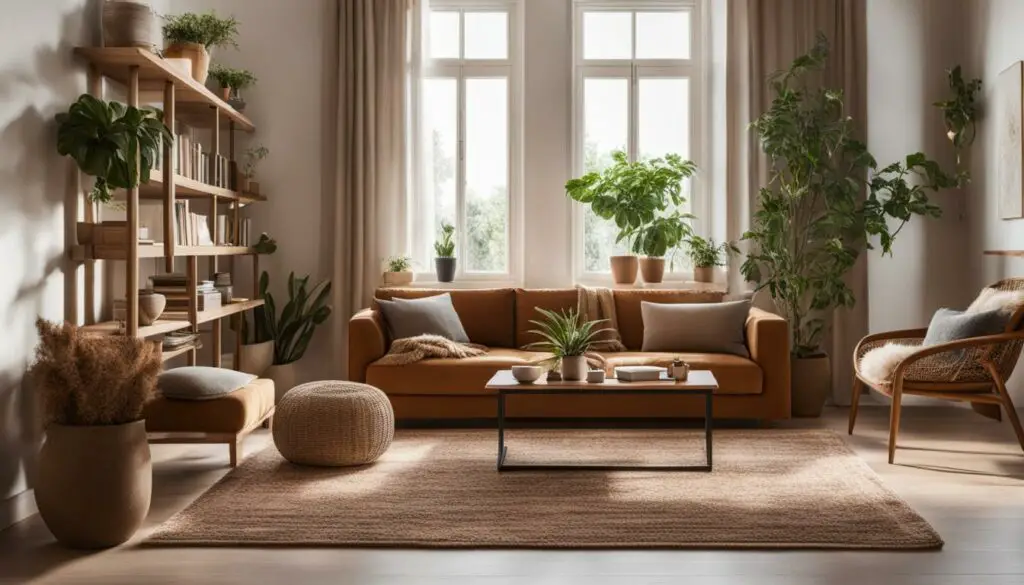
Embracing Feng Shui and Hygge in Every Season
Adapting the principles of feng shui and hygge to each season can help you create an environment that embraces the unique qualities and characteristics of every time of year. Here are some tips to infuse your space with the essence of each season:
Spring
Spring is the perfect time to open your windows and let in the fresh air. Incorporate elements of feng shui by adding plants and flowers that symbolize growth and renewal. Embrace hygge with a cozy reading nook filled with soft blankets and pillows.
Summer
During the summer months, bring in natural light and add bright colors to your space. Feng shui recommends incorporating the fire element with candles or a summer-inspired centerpiece. Hygge can be achieved with outdoor gatherings, refreshing drinks, and cool fabrics.
Fall
As the leaves change colors, bring the outdoors inside with natural elements such as pine cones, acorns, and dried leaves. Feng shui encourages adding metal and water elements to your decor in the fall. Create a hygge atmosphere with cozy blankets, warm drinks, and candles.
Winter
Winter is the perfect time to embrace the cozy and comforting essence of hygge. Add soft lighting with candles or string lights and incorporate warm textiles like faux furs and chunky knits. Feng shui suggests incorporating the water element through the use of reflective surfaces such as mirrors or metallic accents.
By adapting the principles of feng shui and hygge to each season, you can create a space that reflects the changing rhythms of nature and promotes balance and harmony throughout the year.

Incorporating Feng Shui and Hygge in Your Home Today
Are you ready to bring balance and coziness into your living space? Here are some practical tips to incorporate feng shui and hygge in your home:
Declutter and Organize
One of the essential elements of feng shui and hygge is creating a clean and clutter-free environment. Decluttering your space can help promote relaxation and tranquility while also making your home look and feel more spacious. Organize your belongings using storage solutions that are both practical and aesthetically pleasing.
Add Cozy Elements
Integrate cozy elements into your decor to create a warm and inviting atmosphere. From soft blankets and plush pillows to warm lighting and scented candles, these touches will make your home feel like a sanctuary.
Optimize Furniture Arrangement
Arrange your furniture in a way that optimizes the flow of energy and promotes balance. Be mindful of the placement of your bed, desk, and other key pieces of furniture. Use feng shui principles like the bagua map to guide you.
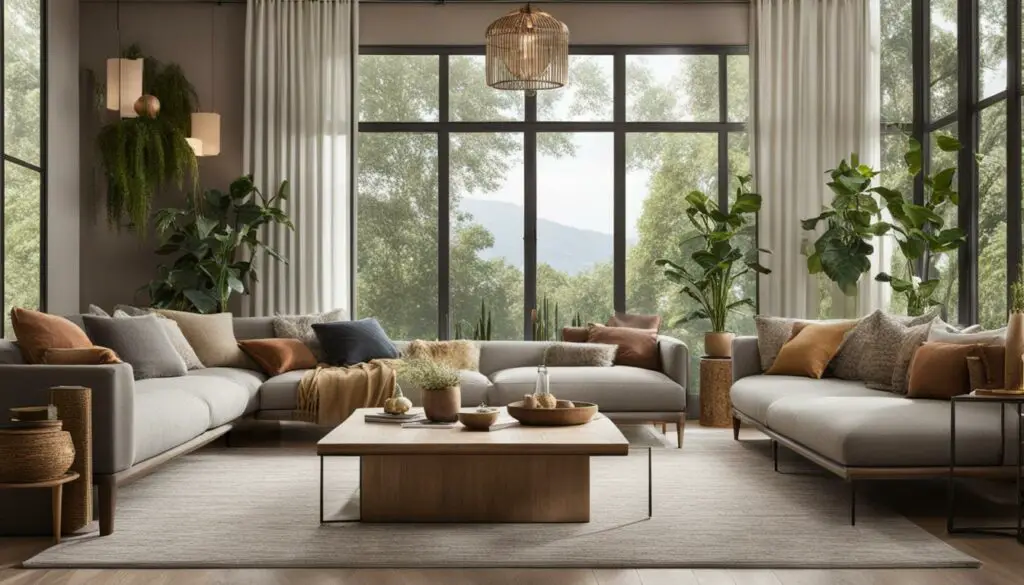
Make Use of Natural Materials
Hygge embraces natural materials like wood, wool, and cotton. Incorporate these materials into your home decor for a cozy and warm ambiance. Feng shui also emphasizes the use of natural materials to promote harmony and balance.
Embrace Color
Color can have a significant impact on mood and energy. Select colors that align with your intentions and energies. Feng shui principles can help guide you in your color choices to optimize the energy of your home. Hygge embraces neutral colors, creating a calming and peaceful atmosphere.
With these tips, you can start incorporating feng shui and hygge in your home today, creating a well-balanced and inviting space that promotes relaxation, happiness, and contentment.
Conclusion
Creating a harmonious and cozy environment is essential for our well-being. By exploring the principles of feng shui and hygge, you can learn how to balance the energy flow within your space and embrace the warmth and simplicity of a comforting atmosphere.
Whether you choose to incorporate feng shui by arranging furniture and decor to promote a positive flow of qi, or hygge by adding candles and blankets to create a cozy ambiance, the key is to create a space that reflects your unique personality and nurtures your soul.
Embrace the Best of Both Worlds
Why choose between feng shui and hygge when you can have the best of both worlds? By combining the elements of these two design philosophies, you can create a truly balanced and fulfilling environment that promotes your well-being.
Craft Your Perfect Environment
Whether you’re looking to create a serene bedroom, a cozy living room, or a productive home office, feng shui and hygge principles can be adapted to every space. By incorporating these principles into your daily routines and mindset, you can achieve a more balanced and fulfilling lifestyle.
Start Today
Take actionable steps to incorporate feng shui and hygge in your home starting today. Declutter and organize your space, add cozy elements such as blankets and cushions, and embrace natural materials and soft lighting to create a comforting atmosphere. Remember, the key is to craft your perfect environment where balance and coziness coexist.
FAQ
What is the difference between feng shui and hygge?
Feng shui is an ancient Chinese practice that focuses on harmonizing the energy flow within a space, while hygge is a Danish concept that emphasizes creating a cozy and comfortable atmosphere. Feng shui aims to promote balance and prosperity, while hygge is focused on relaxation and contentment.
How can I incorporate feng shui in my home?
To incorporate feng shui in your home, it’s important to understand its basic principles such as the bagua map, five elements, and yin and yang. You can then arrange furniture and decor in specific ways to optimize the energy flow and create a balanced environment.
What are some hygge decorating tips?
Some hygge decorating tips include adding soft lighting, using natural materials, creating cozy reading nooks, and incorporating elements that bring warmth and comfort, such as candles and blankets.
Can feng shui and hygge be combined?
Yes, feng shui and hygge can be combined to create a harmonious and cozy atmosphere. By incorporating elements from both design philosophies, you can optimize the energy flow in your space while creating a warm and inviting environment.
How can feng shui and hygge benefit me?
Incorporating feng shui and hygge in your home can have several benefits, including improved well-being, increased relaxation, better sleep, enhanced productivity, and a greater sense of happiness and contentment.
Can feng shui and hygge be applied to specific spaces?
Yes, feng shui and hygge can be applied to specific spaces in your home, such as the bedroom, living room, and home office. By following the principles of feng shui and hygge, you can create serene and inviting environments in each space.
How can I incorporate feng shui and hygge in my daily life?
Feng shui and hygge can extend beyond interior design and become a way of life by incorporating these principles into your daily routines and mindset. By embracing the core elements of both philosophies, you can achieve a more balanced and fulfilling lifestyle.
How can I adapt feng shui and hygge to different seasons?
Adapting feng shui and hygge to different seasons involves infusing your space with the essence of each season. From incorporating seasonal decor and colors to adjusting lighting and creating cozy spaces, you can create an environment that embraces the unique qualities of each time of year.
How can I incorporate feng shui and hygge in my home starting today?
To incorporate feng shui and hygge in your home starting today, you can begin by decluttering and organizing your space, adding cozy elements such as candles and blankets, and creating areas that promote relaxation and comfort. These small steps can make a big difference in creating a well-balanced and inviting environment.

